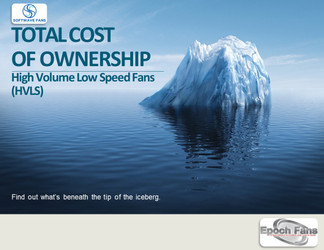Executive Summary:
To achieve clear investment decisions, it's crucial to estimate cash flows accurately by understanding the total cost of owning assets over their lifespan. Reducing ownership costs improves cash flows and investment returns. However, identifying these costs requires a common understanding across different cultures and industries, as terminology can vary. Historical experiences offer guidance on which factors to consider. The Total Cost of Ownership (TCO) playbook serves this purpose, offering a checklist for cost assessment, a shared vocabulary for effective communication, and a framework for both qualitative and quantitative TCO analysis. It helps make informed decisions using a method developed by teams at Arian Flux Technologies (softwavefans.com) and Falco eMotors Inc (epochfans.com). Addressing a significant challenge in the HVLS Fan industry, it establishes a TCO standard, providing OEMs with criteria, guidelines, and checklists that encompass all significant costs, from acquisition to disposal. This initiative, which was contributed to by experts, aims to fulfill expectations in capital equipment transactions by fostering dialogue and collaboration. This playbook provides a standardized framework and common vocabulary to facilitate informed decision-making, promoting transparency and collaboration throughout acquisition.
Call to Action:
Unlock the true value of HVLS fans by leveraging this guide to make informed investment decisions that empower your business to thrive.

I. Acquisition Costs:
This section meticulously assesses all costs associated with acquiring your HVLS fans:
Equipment Design and Application: Consider factors like custom requirements, engineering specifications, and compatibility with your environment.
Project Requirements: Detail any unique project aspects like permits, drawings, or site surveys.
Installation: Evaluate fabrication, labor, and integration costs with existing infrastructure.
Initial Training: Ensure your team can operate and maintain the fans effectively.
Validation and Testing: Verify performance and compliance with industry standards.
Utility and Energy Costs: Factor in anticipated power consumption and potential rebates or incentives.
II. Operation and Maintenance Costs:
This section delves into the ongoing expenses associated with using your HVLS fans:
Quality and Reliability: Consider the long-term durability and performance of the fans.
Labor: Assess staffing needs for operation, maintenance, and adjustments.
Maintenance, Set-up, and Changeover: Account for scheduled and unscheduled maintenance and any adjustments required for different operating conditions.
Cleaning and Sanitization: Factor in cleaning frequency and associated materials based on your environment.
Training: Include ongoing training for operational and maintenance personnel.
Utilities and Environmental Impact: Analyze ongoing energy consumption and potential environmental effects.
III. Value Proposition:
This section highlights the compelling reasons to standardize TCO and utilize this playbook:
Why Standardize TCO? Why Now? Understand the benefits of transparent and consistent cost calculations for buyers and sellers.
International Sourcing Applications: Apply the TCO framework to evaluate international sourcing options effectively.
Operating and Acquisition Cost Checklists: Leverage the provided checklists to streamline your TCO analysis and ensure no cost factors are overlooked.
By adopting this standardized approach, you can make informed investment decisions, foster effective communication, and maximize the value proposition of your HVLS fans. Embrace transparency and collaboration to unlock the true potential of this technology and propel your business forward.

